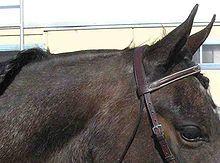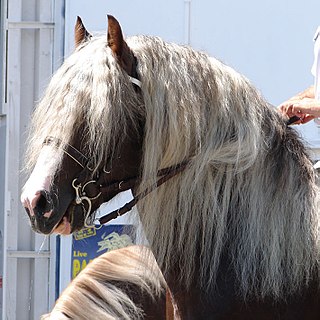Tack refers to equipment or accessories equipped on horses and other equines in the course of their use as domesticated animals. Saddles, stirrups, bridles, halters, reins, bits, harnesses, martingales, and breastplates are all forms of horse tack. Equipping a horse is often referred to as tacking up. A room to store such equipment, usually near or in a stable, is a tack room.
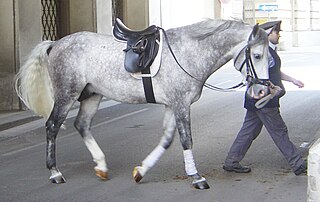
English saddles are used to ride horses in English riding disciplines throughout the world. The discipline is not limited to England, the United Kingdom in general or other English-speaking countries. This style of saddle is used in all of the Olympic and International Federation for Equestrian Sports (FEI) equestrian disciplines, except for the newly approved FEI events of equestrian vaulting and reining. Most designs were specifically developed to allow the horse freedom of movement, whether jumping, running, or moving quickly across rugged, broken country with fences. Unlike the western saddle or Australian Stock Saddle, there is no horn or other design elements that stick out above the main tree of the saddle.
Equitation is the art or practice of horse riding or horsemanship.
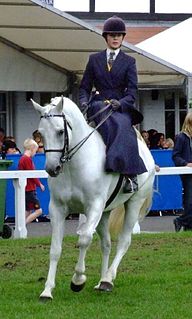
Sidesaddle riding is a form of equestrianism that uses a type of saddle which allows a rider to sit aside rather than astride an equine. Sitting aside dates back to antiquity and developed in European countries in the Middle Ages as a way for women in skirts to ride a horse in a modest fashion while also wearing fine clothing. It has retained a specialty niche even in the modern world.

Western Pleasure is a western style competition at horse shows that evaluates horses on manners and suitability of the horse for a relaxed but collected gait cadence and relatively slow speed of gait, along with calm and responsive disposition. The horse is to appear to be a "pleasure" to ride and very comfortable, while being very smooth. Most light horse breeds in the United States and Canada may compete in western pleasure classes, either in open competition or at shows limited to a single breed. However, horse conformation and temperament play a role in this event, and hence animals that are calm, quiet, have collected, soft gaits and the strong muscling required to sustain slow, controlled movement are the most competitive.

The hunter–jumper division also known as working hunter classes is a branch of showing where a horse is judged on its suitability for hunting. The class is split into two parts, jumping and conformation. The horse is judged on jumping, movement, conformation and manners In North America, a "show hunter" is a horse that competes in this division, however in the UK and Ireland many breeds compete within these classes. Whilst there are similarities between the American and British classes, there are differences in scoring, attire and type.

Hunt seat is a style of forward seat riding commonly found in North American horse shows. Along with dressage, it is one of the two classic forms of English riding. The hunt seat is based on the tradition of fox hunting. Hunt seat competition in North America includes both flat and over fences for show hunters, which judge the horse's movement and form, and equitation classes, which judge the rider's ability both on the flat and over fences. The term hunt seat may also refer to any form of forward seat riding, including the kind seen in show jumping and eventing.
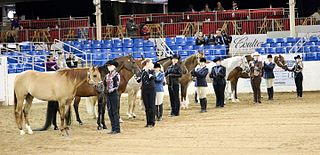
Showmanship is an event found at many horse shows. The class is also sometimes called "Fitting and Showmanship", "Showmanship In-Hand", "Showmanship at Halter" or "Halter Showmanship" It involves a person on the ground leading a horse, wearing a halter or bridle, through a series of maneuvers called a pattern. The horse itself is not judged on its conformation. Rather, the exhibitor is judged on how well he or she exhibits the animal to its best advantage, with additional scoring for the grooming and presentation of both horse and handler.

The forelock or foretop is a part of a horse's mane, that grows from the animal's poll and falls forward between the ears and onto the forehead. Some breeds, particularly pony breeds, have a naturally thick forelock, while other breeds, such as many Thoroughbreds, have a thinner forelock. Primitive wild equines such as the Przewalski's horse with a naturally short, upright mane generally have no hair falling forward onto the forehead. Other equidae such as donkeys and zebras, have no discernible forelock at all.
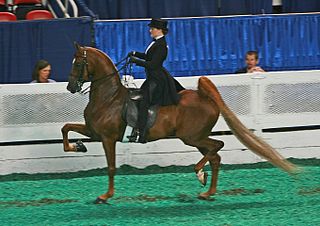
Saddle Seat is a style of horseback riding within the category of English riding that is designed to show off the high action of certain horse breeds. The style developed into its modern form in the United States, and is also seen in Canada and South Africa. To a much lesser extent, it is ridden with American action horse breeds in Europe and Australia. The horse breeds mainly used for this flashy style are typically the showy Morgan Horse, and the high stepping American Saddlebred.
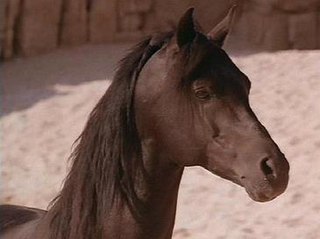
Cass Ole was a Texan-bred Arabian stallion. Originally bred to be a show horse, he was National Champion in Arabian Western Pleasure in 1975, National Reserve Champion Arabian Ladies Side Saddle in 1976, and U.S. Top Ten Arabian English Pleasure in both 1975 and 1976. He won over 50 championships and over 20 Reserve Championships in his seven-year show career and was high point winner of the King Saud Trophy of the American Horse Show Association. He is best known for his role as The Black in the films The Black Stallion and The Black Stallion Returns, in which he is credited as Cass-Olé.
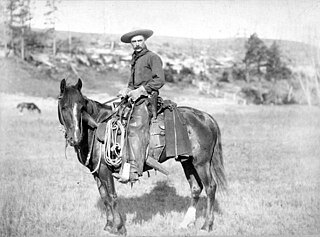
Western riding is a style of horse riding which evolved from the ranching and warfare traditions brought to the Americas by the Spanish Conquistadors, and both equipment and riding style evolved to meet the working needs of the cowboy in the American West. American cowboys needed to work long hours in the saddle over rough terrain, sometimes needing to rope cattle with a lariat. Because of the necessity to control the horse with one hand and use a lariat with the other, western horses were trained to neck rein, that is, to change direction with light pressure of a rein against the horse's neck. Horses were also trained to exercise a certain degree of independence in using their natural instincts to follow the movements of a cow, thus a riding style developed that emphasized a deep, secure seat, and training methods encouraged a horse to be responsive on very light rein contact.

Halter is a type of horse show class where horses are shown "in hand," meaning that they are led, not ridden, and are judged on their conformation and suitability as breeding stock. Depending on breed and geographic region, such events may be called "Halter," "In-Hand," "Breeding," "Model," or "Conformation" classes.
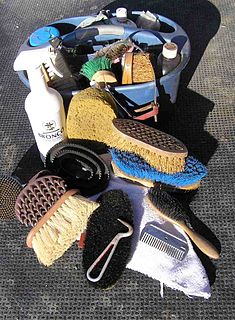
Horse grooming is hygienic care given to a horse, or a process by which the horse's physical appearance is enhanced for horse shows or other types of competition.

Mountain and moorland or M&M ponies form a group of several breeds of ponies and small horses native to the British Isles. Many of these breeds are derived from semi-feral ponies kept on moorland or heathland, and some of them still live in this way, as well as being kept as fully domesticated horses for riding, driving and other draught work, or for horse showing.

For the plant horsetail see Equisetum.
